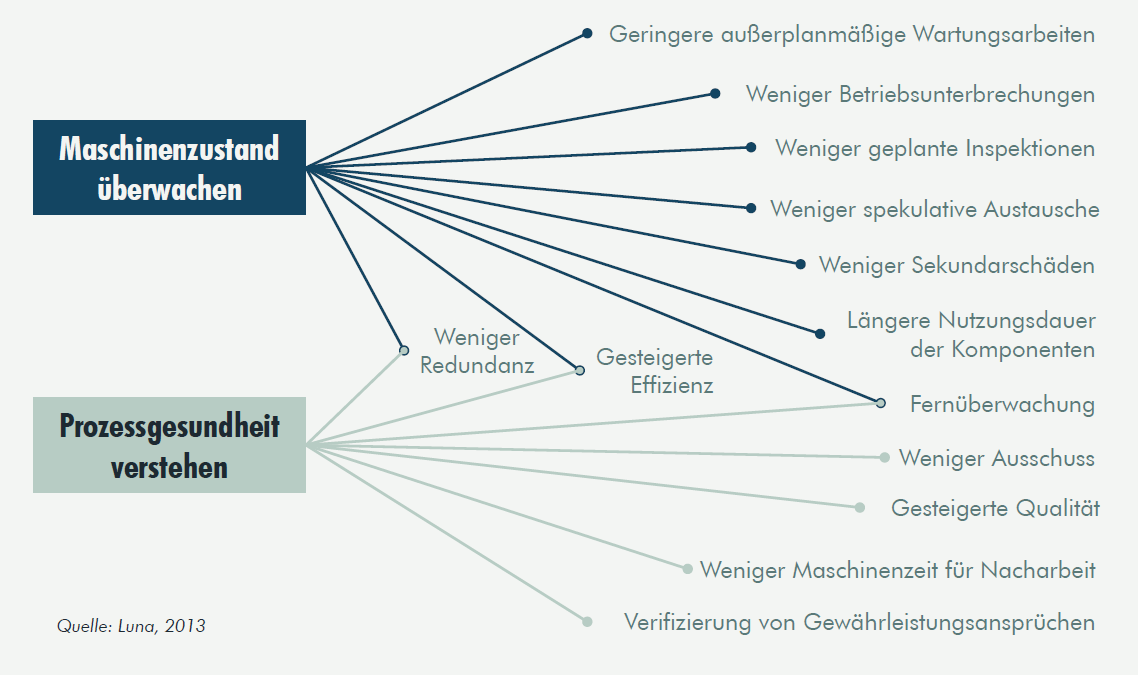Manufacturing Prognostics und der Mittelstand (erschienen in FMPro 12/2022)
Die intelligente Produktionsmaschine ist längst keine reine Zukunftsmusik mehr. Massgeschneiderte künstliche Intelligenz (KI) trifft man immer häufiger in den Fertigungsstrassen von heute an. In den vergangenen zwei Jahren stösst man zunehmend häufiger auf die jungen Manufacturing Prognostics Services der Maschinenhersteller. Jüngst integrierte Trumpf einen Service zur Maschinenüberwachung in seine Oseon-Software. EMAGs Edna Health Check beinhaltet ein ähnliches Wertversprechen. Eine Analyse der Produktportfolios von schweizer Maschinenbauunternehmen zeigt: In der Schweiz vermarkten ca. 13% der Unternehmen im Maschinenbau datengetriebene Lösungen auf fortgeschrittenem Niveau. Die wenigsten fallen in die Klasse der kleinen und mittelständischen Unternehmen (KMUs).
Künstliche Intelligenz – ein Thema der Branchengrössen?
„Der Mittelstand kann KI nicht“ – diese Aussage sei schlichtweg falsch, so Julius Kirschbaum. Der gelernte Wirtschaftsingenieur jährige weiss wovon er spricht. Er setzt sich als Innovationsforscher am Chair of Information Systems in Nürnberg mit den digitalen Transformationsprozessen produzierender Unternehmen auseinander. In einem Konsortium aus Industrie und Forschung begleitet er die Entwicklung und Einführung der IIP-Ecosphere, einer Datenplattform, die neue Massstäbe in Bezug auf Open Innovation in der Digitalisierung setzen möchte.
Beim Begriff des „Mittelständlers“ – fast 60% des Wertschöpfungsbeitrags der Schweizer Industrie fällt in diese Kategorie – müsse bereits differenziert werden. Es gebe nicht das KMU. Der regional etablierte Automatisierer, der hochspezialisierte Komponentenhersteller, dessen Produkt sich als wenig bekanntes wenngleich unverzichtbares Bestandteil in vielen Fertigungssystemen wiederfindet, und der global agierende Mikrotechnikhersteller fallen allesamt in diese Klasse – sie als vielfältig zu bezeichnen wäre eine Untertreibung.
Der Digitalisierungsvorsprung bestimmter Branchen liegt nahe: Die Ausgangsposition eines Elektronikherstellers ist von Natur aus eine ganz andere als die eines Stahlwerks. Pauschalisieren darf man das aber keinesfalls. Pioniere seien in allen Branchen zu erkennen, so Herr Kirschbaum. Er sucht nach Mustern und Erfolgsfaktoren. Was man bei vielen der KI-Früheinsteiger erkenne, sei ein ausgeprägtes Selbstverständnis des Unternehmens als digitale Organisation. Die strategische Entscheidung zur Entwicklung KI-gestützter Prozesse und Dienstleistungen sei in diesen Organisationen naheliegend und befeuere den langfristigen unternehmensweiten Transformationsprozess.

Mehr Wert aus den Daten der eigenen Fertigungsprozesse ziehen – wohl kaum ein Mensch aus der Unternehmensführung wird sich in den vergangenen Jahren nicht zumindest gedanklich mit diesem Wunsch auseinandergesetzt haben. Die Sensoren moderner Fertigungsanlagen erfassen im Millisekundentakt hunderte von Datenpunkten. Versteckt darin enthalten sind hochaktuelle Informationen über den Gesundheitszustand der eigenen Anlagen und der Qualität des eigenen Prozesses. Liegen ausreichend Daten vor, sind moderne Verfahren der KI in der Lage, diese versteckten Informationen als nutzbar zu machen. Dank solcher Manufacturing Prognostics Lösungen können Maschinenausfälle vorhergesehen werden, Komponentenlebensdauern dank vorrausschauender Wartungsstrategien verlängert werden (Predictive Maintenance) oder Qualitätsabweichungen in den Prozessdaten frühzeitig erkannt und lokalisiert werden (Predictive Quality). Es überrascht nicht, dass manch ein Vordenker der Industrie schnell darin ist, Daten als das neue Öl auszurufen. Nur ist Erdöl in seiner Rohform ziemlich eingeschränkt nutzbar. So steht es auch um diese neue Ressource. Ohne die entsprechende Datenpipelines, -Aufbereitungsprozesse und -Speicher bleibt die eigene KI-Lösung Wunschdenken.
Früheinsteiger investierten zunächst in ihre Datenarchitektur
Um ihr Datenkapital nutzbar zu machen, haben die Früheinsteiger zunächst in die Entwicklung der eigenen Datenarchitektur investiert. Allein dieser Prozess dauert in der Regel mindestens zwei Jahre. Ihn begleiten wichtige Fragen: Welche Daten werden gespeichert, und wo? Wie betreibt man datengetriebene Lösungen sicher in kritischen oder sensiblen Fertigungsprozessen? Unternehmen haben gelernt, dass solche Fragen nicht einfach an die IT-Abteilung ausgelagert werden können. Generell sei dies ein weiterer Indikator: Erfolgreiche Unternehmen erkenne man bereits daran, wie die IT-Abteilung in das Unternehmen eingegliedert sei. Es gebe gute Modelle zur Beurteilung des digitalen Reifegrads eines Unternehmens, wie den Industry 4.0 Maturity Index. „Häufig merkt man aber schon, wie es um die Digitalisierung im Unternehmen steht, wenn man zuhört, wie IT und Produktion miteinander sprechen.“, so Herr Kirschbaum.
Hürden und Erfolgspotenziale im Mittelstand
Selten reicht ein einziges Spezialistenteam im Unternehmen, um alle Facetten von Datenengineering, KI-Entwicklung und -Betrieb abzudecken. Manch ein pragmatischer Mittelständler mag angesichts der Investitionsfülle an der Sinnhaftigkeit des unternehmenseigenen KI-Programms zweifeln. Gepaart mit einer Vielzahl von unbeantworteten Rechtsfragen um den KI-Einsatz und einem unklaren Geschäftsmodell wird die KI-Entwicklung in vielen Unternehmen noch auf Sparflamme betrieben.
„Wir sprechen mit kaum einem Unternehmen, in dem man nicht irgendwo die verstaubten Powerpoint-Folien eines gescheiterten internen Predictive Maintenance Projekts hervorkramen kann.“, so Till Schöpe. Er hat am CSEM, einer Schweizer Innovationsschmiede über mehrere Jahre Lösungen im Feld der Manufacturing Prognostics entwickelt und sich eingesetzt, KMUs zu industriereifen KI-Lösungen zu verhelfen. Besonders traurig stimme es ihn, wenn er erlebe, wie Herzblut in die Entwicklung einer funktionierenden Lösung gesteckt wurde, um dann zu erleben, dass die Lösung nie über die Proof-of-Concept-Phase hinaus betrieben wurde.
Als Gründer und CTO von Alpamayo Intelligent Quality Solutions sieht er sich in der Fortsetzung dieser Mission. „Wir wollen KI-Lösungen für den produzierenden Mittelstand zugänglicher machen.“ Eine Standardisierung von KI-Lösungen mit industriellen Zeitreihendaten, wie sie mit den Bilddaten schon seit mehreren Jahren im Gange ist, sei längst überfällig. Er ist überzeugt: diese Standardisierung wird zu massiven Effizienzgewinnen in der KI-Entwicklung führen und sie wird es erlauben, mit skalierbarer Software den aktuell hohen individuellen Overhead im Datenengineering und Betrieb von KI-Lösungen weiter zu senken. Mit erprobten Lösungen reduziere sich zudem das technologische Risiko der KI-Entwicklung.
Mit dieser Motivation steuert er die Softwareentwicklung bei Alpamayo. Im Blick hat er vor allem die Second-Mover, die bei Manufacturing Prognostics jetzt einsteigen wollen: „Viele KMUs sind zwar im Rückstand, doch dank der Erfahrungen der Vorreiter kann man umso schneller aufschliessen. Die kurzen Entscheidungswege in KMUs helfen hier umso mehr.“
Am Ende laufe es gerade bei Mittelständlern auf eine „Make-Buy-or-Allie“-Entscheidung hinaus, folgert Herr Kirschbaum. Während manch ein grösserer Akteur sich dank seiner Entscheidung zum „Make“ eine Vorreiterrolle erarbeiten konnte, so könnten Open Innovation Prozesse und die massgeschneiderten Angebote von Startups wie Alpamayo genau die Bausteine sein, die der KI zu ihrem Erfolgsmoment im produzierenden Mittelstand verhelfen wird.









